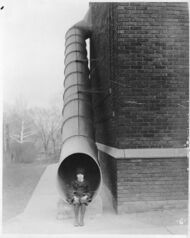Engineering:Escape chute

An escape chute is a special kind of emergency exit, used where conventional fire escape stairways are impractical. The chute is a fabric (or occasionally metal) tube installed near a special exit on an upper floor or roof of a building, or a tall structure. During use, the chute is deployed, and may be secured at the bottom by a fire fighting crew some distance out from the building. Once the tube is ready, escapees enter the tube and slide down to a lower level or the ground level.
Description
Although some early escape tubes were made entirely of metal, most current designs are made of high-strength fabrics, such as Kevlar. Their flexibility allows for compact storage, rapid deployment, and a gentler braking and controlled descent of users, as compared to traditional metal designs. Fabric tubes may also incorporate inflatable elements to lend some degree of structural rigidity and stability to the escape chute. The fabrics chosen must have flame retardant properties as well.[1]
In addition to fixed escape chutes permanently installed onto buildings, mobile escape systems are produced which can be mounted on the basket of a movable fire truck ladder, or temporarily installed to a building in an emergency.[2]
In response to images of trapped office workers in the September 11 attacks, personal escape devices for emergency use have been proposed, but only rope-based systems appear to be on the market for personal use.[3]
There was also the issue of fire heating the metal tubes, causing the people inside the metal tubes to become severely burned while exiting the building.
Escape chutes are also installed in air traffic control towers where space for redundant stairwells is limited. Escape chutes were tested at the control tower at Kadena Air Base.[citation needed]
Types of Escape Chute
There are two main Types of Escape chutes : Internal and External.[4]
Internal Escape Chutes
- Located inside a building, and are commonly positioned away from stairwells.
- Can be used by people inside the building and can be quickly deployed in an emergency.
- Protected against rain, dust, and rodents. They are long-lasting and can be used repeatedly.
- Well designed to safely carry people down to ground level in an emergency.
External Escape Chutes
- Installed Outside a building, like near the window, balcony, or terrace
- Can be easily accessed by both Inside and Outside people of the building in a matter of seconds.
- The chute can bear the heavy load to get everyone evacuated easily and safely in an emergency situation.
- They are made with durable materials that can easily withstand harsh weather and can be used multiple times.
History
In 1948, the 136-bed Georgia Baptist Hospital in Atlanta featured a large fabric escape chute that was claimed to be able to empty the hospital "in only a few minutes".[5]
An escape chute system was installed at the Cape Canaveral launchpads for the now-discontinued NASA Space Shuttle, to allow personnel to rapidly reach a safety refuge blast shelter in the event of an imminent fire or explosion. The system was tested, but never deployed in actual use.[citation needed]
See also
- Detrainment device
- Evacuation slide
- Fireman's pole
References
- ↑ "Personal Safety Escape Chute". Axel Thoms. http://www.escape-chute.net/neu/uk/safety_equipement.php. Retrieved 21 March 2013.
- ↑ "Rescue Chute". Axel Thoms. http://www.escape-chute.net/neu/uk/safety_passage.php. Retrieved 21 March 2013.
- ↑ "EXO: Personal escape system with anchor hook adapted for locations where the possibility of finding an anchor point is uncertain". Petzl. http://m.petzl.com/en/Professional/Descenders/EXO. Retrieved 21 March 2013.
- ↑ "Fire Escape Chute 2023– A Complete Guide" (in en-US). 2023-06-05. https://sauryahse.com/fire-escape-chute/.
- ↑ "Escape Chute (Apr, 1948)". Modern Mechanix: Yesterday's Tomorrow Today. Mechanix Illustrated. April 1948. http://blog.modernmechanix.com/escape-chute/. Retrieved 21 March 2013.
External links
- "Escape Chute for Vertical Descent". Axel Thoms. http://www.axelthoms.com/docs/ESCAPE%20CHUTE%20FOR%20VERTICAL%20DESCENT.pdf. Retrieved 21 March 2013. — Product brochure, including detailed technical diagram of deployed chute
- "VERTI-SCAPE Vertical Escape Chute". Verti-Scape. Escape Chute Systems. http://www.escape-chute-systems.com/verti_scape_escape_chute.htm. Retrieved 21 March 2013. — review of basic concepts, no actual products shown
 |



